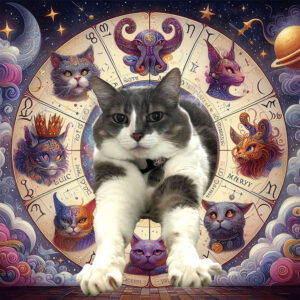While Egyptian considered cats divine symbols and magic creatures that bring luck to people who help and house them, the catholic church in the thirteenth century had a completely different opinion about our little feline friends.
Not only were innocent women killed during the inquisition around Europe, but burning cats became a terrible common practice that also traveled to North America through the Puritan colonist.
All this anti-cat paranoia resulted from an official church document called “Vox in Rama”, issued by pope Gregory IX in 1233, based on the testimony of Konrag of Marbug, a german priest famous for his very questionable confession methods while torturing prisoners. He described how a satanic cult performed rituals worshiping Satan, how people would gather around and black cats participated in the ceremony.

This is not the first time church people looked for pagans wherever they saw a cat; around 1170, the Waldenses, a Christian sect that believed that people could contact directly to God, were accused of worshipping the devil that had the form of a cat. The same accusation would be used to declare the Cathars and even the Knight Templar heretics. The prejudice against our beloved felines was created.
The practice of burning cats near churches or throwing them alive from a high tower, named the Kattenstoed lasted until 1817. Nowadays, there are some parades in Belgium where people get dressed like cats to commemorate the soul of poor felines.

In the time of Black Pagle, cats were also blamed for spreading the disease and were killed in masses; ironically, this increased the population of rats more quickly, and with them, the natural carrier of the bubonic plague, the flea.
Middle age was not a good time to be a cat, especially a black one, they were synonymous with profane, and if a cat crossed your path, a witch could cast any spell on you.
This is Halloween!!
Scholars believe that the relationship between Halloween resides in the Celtic Samhain festival, which happened mainly in Ireland 2500 years ago on November 1st.
During the 16th century, it was recorded that people impersonated the soul of the dead in Scotland and Ireland wearing costumes and collecting offerings during nightfall. Sounds familiar?
Reading about this festivity that marked the beginning of the winter, I find two connection points, if there aren’t more. First, on this date, the veil between the world of the living and the world of Fairy and Spirits became thin, so all types of encounters could happen. All spirits, the good ones, the evil ones, fairies, and supernatural beings on earth will be among us. That being said, we can relate that the witches and their beloved cats enter to the Samhain party as supernatural entities.

Some records also mentioned the presence of a fairy cat named Cat-sìth, a Celtic mythological creature in the form of a large black cat with a white spot on its chest.
During Samhain, you leave a saucer of milk in from of your house in order not to be coursed and bless your home.
A noticeable controversy that got my attention was the summoning of this legendary demon fairy. People had to burn cats for four days and nights for Cat-sith to appear and grant their wishes, so this is exactly what Kattenstoed was about, just burning cats near churches but for the opposite purpose.
So we found here the black cat Samhain relationship, but what about Halloween? In 609, Pope Boniface IV decided to honor all Christian martyrs with All Martyrs Day on May 13, but later pope Gregory III included all saints in the celebration and moved the date to November 1st.
Christianity’s expansion into the Celtic territories brought an inevitable mix of cultures between the Samhain and Christian rites. Later All souls’ day was moved to November 2nd in a failed intent of the church to differentiate the celebrations. People started assimilating both days with Celtic customs, and All saints’ day changed its name to All-hallows. Over the upcoming years, “All Hallows Eve” (October 31- Samhain eve according to Celtic tradition), eventually became Halloween and Meowlloween for all cat lovers, of course.

Sources:
- History Channel – History of Halloween and superstitions
- Catsparella.com – Kattenstoet festival
- Washingtonpost.com – The spooky history of how cats bewitched us
- Litter-robot.com – How did black cats become Halloween symbols.



